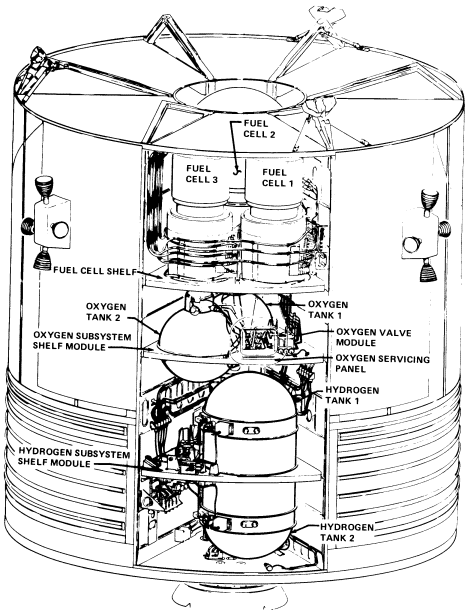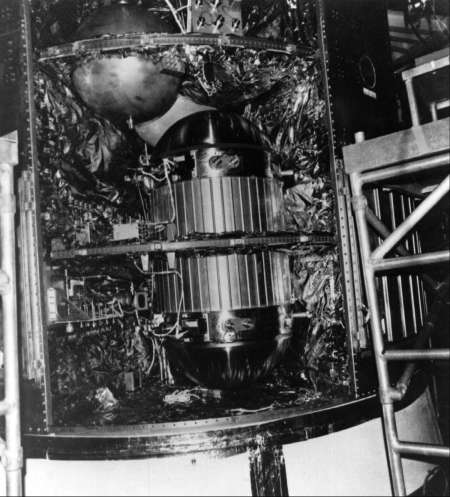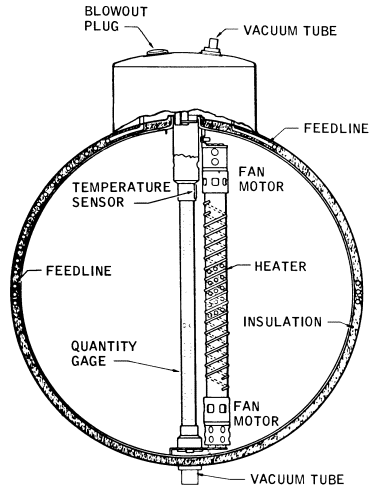
A Fragile Lifeboat
The Apollo 13 countdown proceeded without a major incident, and liftoff came at 2:13 p.m. on 11 April. When the S-II stage's center engine shut down 132 seconds early, an extra 34-second burn from each of the four outboard engines made up most of the difference. An additional nine-second burn of the S-IVB stage brought the vehicle to within 0.4 meters/second of the planned velocity and left sufficient fuel to boost the space vehicle out of the earth's gravitational field.32 Aside from the S-II problem, the first two days of the mission went according to plan. The crew started the third day in space by inspecting the lunar module. Lovell and Haise read a supercritical helium pressure well under the danger line. Fifty-five hours into the mission the crew began a television transmission from the command module, Odyssey. Fred Haise demonstrated movement through the tunnel into the lunar module, Aquarius, and remarked: "There's a little bit of an orientation change that, even though I'd been through it once, in the water tank, is still pretty unusual. I find myself now standing with my head on the floor, when I get down into the LM." For the next half hour the crew described their temporary quarters in a space version of "Person to Person." The television interview ended on a light note as Lovell showed off a floating tape recorder. Musical selections included "Aquarius" from "Hair" and the theme from "2001, A Space Odyssey."33
The good cheer came to a sudden end a few minutes later when the warning system indicated low pressure in hydrogen tank 1. Mission control asked the crew to turn on the cryogenic fans and heaters. Ninety seconds after the fans started up, Mission Control lost all telemetry for two seconds. The crew heard a loud "bang" and observed a low voltage condition on d.c. main bus B.* Swigert reported, "Okay, Houston. Hey, we've got a problem here."34 The full extent of the problem, however, was not immediately apparent. Voltage on main bus B recovered momentarily. The quantity gauge for oxygen tank 2 fluctuated and then returned to an off-scale high reading. Repeated firings of the attitude control thrusters on the service module added to the confusion. According to a later NASA report the thrusters were probably firing to overcome the effects of venting oxygen and a blown panel. Within minutes, the electrical output from fuel cells 1 and 3 dropped to zero. At first the mission controllers focused on the electrical systems, postulating a possible disconnect between the fuel cells and their respective buses. Upon realizing that the fuel cells were not working, mission control directed an emergency powerdown of the command module. With indications of a pressure loss in oxygen tank 1, Houston directed a switch in electrical power to obtain a reading from the number 2 tank's instrumentation. The tank was empty. The reading substantiated a crew report that the spacecraft was venting something into space. As the pressure in oxygen tank 1 continued to drop, Lovell's crew abandoned the mission and sought refuge in the lunar module.
A subsequent investigation pieced together the probable sequence of events. Apparently the start of the fans in oxygen tank 2 caused an electrical short circuit. Damaged Teflon insulation around the fan motor wires caught fire. Although the Teflon burned slowly, increasing heat and pressure soon ruptured the tank. The escaping oxygen either ignited with combustibles in the oxygen shelf compartment or blew an access panel off by itself. The panel struck the spacecraft high-gain antenna, disrupting telemetry signals momentarily. The pressure in oxygen tank 1 began dropping immediately after the telemetry loss. Apparently the same force that blew off the panel also damaged tank 1. The sudden and possibly violent failure of tank 2 may have broken a line to tank 1 or caused a valve to leak.35
The plight of the astronauts reawakened world interest in the Apollo program. Television carried the drama to millions. Foreign countries offered their services for a recovery outside the intended Pacific splashdown area. At the manned spaceflight centers, concern was matched by a determination to return the astronauts safely. Two major activities dominated the remainder of the mission: planning and conducting the propulsion maneuvers with the lunar module so as to bring the spacecraft back to earth, and managing the vital resources - oxygen, water, electricity, and the canisters of lithium hydroxide used to remove carbon dioxide from the cabin atmosphere. Open communications lines between KSC and mission control at Houston carried advice and test requirements. The two centers simulated the various maneuvers and conservation measures before directions were given to the flight crew. A team under Charles Mars, lunar module project engineer, devised a means of recharging the command-service module's re-entry batteries from the lunar module's electrical system. Another KSC recommendation turned off the radar heaters to save electricity. North American and Grumman engineers at KSC helped devise ways to transfer water from the portable life support systems into the lunar module's water coolant system. One of the biggest problems was the removal of carbon dioxide from the crowded Aquarius. KSC engineers, again duplicating activities at Houston, rigged a system that carried the CO2-rich air from the lunar module, through a hose, into the command-service module's lithium hydroxide canisters. Over in KSC's flight crew training building, the Houston team simulated in advance the various situations to be encountered by the astronauts.36
Apollo 13 looped around the moon on 14 April 1970. While the lunar module barely provided room to turn around, the crew preferred its narrow confines to the chilly 11 degrees C of the powerless command module. Respect for Aquarius increased as its systems continued to function well past their two day mission expectancy.37 Splashdown came in the South Pacific on 17 April.
While the dramatic rescue earned plaudits for the entire Apollo team, the mission had failed. Paine took steps to determine the cause of the accident as the astronauts were returning to earth; on the 17th he announced the appointment of an Apollo 13 review board under the leadership of Langley Research Center's Director, Edgar M. Cortright. The board conducted an intensive investigation during the next six weeks and the positive reception of its report contrasted sharply with the earlier Apollo fire investigation. The board concluded "that the accident was not the result of a chance malfunction in a statistical sense, but rather from an unusual combination of mistakes, coupled with a somewhat deficient and unforgiving design."38

Cutaway of the fuel cells and cryogenic tanks in bay 4 of the service module, Apollo 13.

The hydrogen tank shelf, with an oxygen sphere, upper left.

Schematic of the oxygen tank.
Oxygen tank 2 - the one that first ruptured - had undergone acceptance tests at the Beech Aircraft Corporation factory in 1967. The tank was installed in SM-106 (Apollo 10) and later removed for modifications. During the operation, the oxygen shelf was jarred and fell some 5 centimeters. North American officials analyzed the incident and concluded that there was no damage. The review board found the likelihood of tank damage from the incident "rather low," but listed the accident as a possible cause of the loosefitting fill tube. The oxygen shelf was retested after the modifications, but no cryogenics were used. As the components worked satisfactorily, the shelf was installed in SM-109 (Apollo 13) on 22 November 1968.
Unfortunately, when the tank arrived at KSC in June 1969, it had an even more serious shortcoming. The two protective thermostatic switches on its heater were built to 1962 specifications for 28-volt d.c. power. In 1965 North American had issued a revised specification - the heaters would operate on 65 volts for tank pressurization. Beech did not change the thermostatic switches, and both North American and NASA documentation reviews overlooked the error. Subsequent qualification and acceptance tests did not require complete switch cycling, and so they too failed to reveal the incompatibility. During tank pressurization the 28-volt switches could accommodate the 65 volts from KSC's ground support equipment because the thermostats remained cool and closed. However, if the tank temperature rose considerably, as it did for the first time during KSC's special detanking, the 28-volt thermostatic switches would fail. When the switches started to open at their upper limit of 300 kelvins (27 degrees C) on 27 March, the current in the ground equipment welded them permanently closed. The review board estimated that, after the switches failed, temperatures in the tank reached 811 kelvins (538 degrees C) in spots during the eight hours of detanking. The intense heat would have severely damaged the Teflon insulation on the fan motor wires.
As the board indicated, the special detanking on 27 March 1970 did not violate KSC procedures. However, the launch team could have detected the failure of the thermostatic switches to open by observing heater current readings on the control panel. The tank temperatures indicated that the heaters had reached their temperature limit and a switch opening should follow. There was also an apparent communications gap while -the oxygen tank problem was under debate. Attention focused on the loose fill tube, and many individuals at Houston, North American, and Beech were unaware of the extended heater operations. Those aware of the special detanking procedure failed to consider the damage that might result from the excessive heating and did not alert Apollo management to the possible consequences.39
The board summed up the lesson of Apollo 13 in the preface to its report:
The total Apollo system of ground complexes, launch vehicle, and spacecraft constitutes the most ambitious and demanding engineering development ever undertaken by man. For these missions to succeed, both men and equipment must perform to near perfection. That this system has already resulted in two successful lunar surface explorations is a tribute to those men and women who conceived, designed, built, and flew it.Perfection is not only difficult to achieve, but difficult to maintain. The imperfection in Apollo 13 constituted a near disaster, averted only by outstanding performance on the part of the crew and the ground control team which supported them.40
* An electrical bus is a conductor that serves as a common connection for several circuits.
| Next |